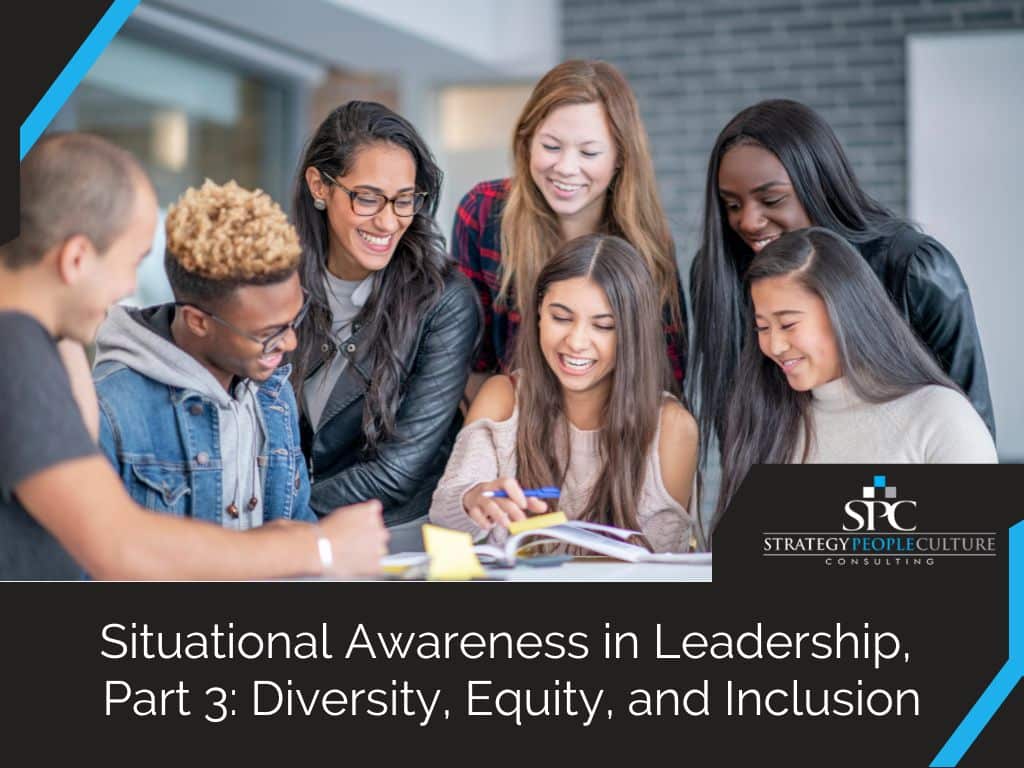Situational Awareness in Leadership, Part 3: Diversity, Equity, and Inclusion

For the past two blog posts, we’ve covered the topic of situational awareness. This is the ability to perceive your surroundings, properly interpret what is happening, and act according to what you determine may happen next. One of the most important elements of good situational awareness is a mental framework based on experience. This experience is key, especially when it comes to handling issues related to diversity, equity, and inclusion (DEI).
Why is this so? How society views us and our experiences in life tend to be framed by our appearance, speech, or customs. That is, we are all, at times, viewed through the lens of others’ biases. And that view often determines how people treat us. The workplace is not immune to these biases, and leaders need to be aware of them.
When leaders seem aloof to an employee’s discomfort with their co-workers’ comments or treatment, it is usually not because they are thoughtless. They simply haven’t experienced what the other person is going through, and they don’t have the mental framework in place to be situationally aware. In other words, without active thought and input from others, it is difficult, if not impossible, to form the framework needed to respond in a situationally aware way when DEI issues arise.
What are some ways to resolve this? We’ll explore this below.
Building the Mental Framework of Experience

The best way to develop knowledge that isn’t part of your everyday experience is simply to find a way to walk in someone else’s shoes. But this isn’t always easy. Conversations along these lines can be awkward, and following someone for a day can be intrusive. Fortunately, there are plenty of works of non-fiction, both books, and films, that can reveal the world through the eyes of someone in a traditionally marginalized group. One book we recently read is called “The Conversation” by Robert Livingston. This is a great example of a Science-Based Approach to discussing and bias. This is different from DEI training. Classes typically discuss issues and make points about awareness and inclusion. But classes often do not give you the first-person experience that essays or even works of non-fiction can give. Even essays or poetry can transport you into someone else’s life to see what their experience may actually feel like, allowing you to take that walk in that other person’s shoes. And this can be extremely powerful for developing a mental framework for situational awareness.
The Harvard Business Review (HBR) article, Male Allyship Is About Paying Attention, recommends self-education first to increase situational awareness of workplace DEI issues. Once you’ve had a chance to do this kind of “homework,” bringing these points of view to the workplace can be very eye-opening. You may notice in a way you hadn’t before some behaviors that could be negatively perceived by co-workers from traditionally marginalized populations. Part of situational awareness includes learning about how a population experiences words or actions that may seem harmless to you and then noticing when they occur at the office; these are two essential leadership attributes that ultimately keep a team accomplishing tasks seamlessly and meeting deadlines.
This same article suggests another way to get to know what others experience once you’ve done a little legwork on your own.
The Power of Asking AND Listening

The HBR article states, “Often, a humble and curious question goes a long way toward building better empathy and situational awareness.” People in traditionally marginalized groups can be reluctant to bring up a negative experience they’ve had to someone they believe has not shared a similar event – especially to their leaders. But asked in the right way at the right time, a question can get someone to open up about how a comment or interaction made them feel. And armed with awareness gleaned from prior research, this conversation can be especially fruitful.
Here’s an example of how this may come up in a business leader’s day. You’ve had an important meeting with a group of your team leaders. You happen to notice that one person in this group tries to offer her ideas, but the others in the group tend to talk over her. Or at times, they let her speak but do not build on her thought and go back to the previous point made. Or your colleagues may look at each other instead of at her while she is speaking. These behaviors may be subtle and miss your attention without situational awareness. But if you are observant, you will not only notice but also know how to react appropriately and immediately to avoid issues.
In the meeting, you may address it by asking her some follow-up questions to allow her to expound on her point. This will provide her the chance to contribute to the meeting’s goals. Then, after the meeting, it may be a good time to ask the “humble and curious question” to encourage the employee to open up if she is receptive. The right questions may start a productive discussion and improve your framework for even better situational awareness in the future.
How to Ask

Based on the HBR article, some good conversation starters could include:
- “I’m curious about some things that happen in this organization daily that women (or any other traditionally marginalized group) may find challenging, which I may not notice.”
- “Are there things people do that you wish they were more aware they were doing or that they would stop doing to make the environment feel more comfortable for everyone?”
- “Is there something I could be more aware of, or maybe something I could do that would make the office environment better for you (as a woman or member of a group)? If so, what can I do?”
None of these conversations need to mention names or other specifics. They can be very general. But done with genuine caring, they can give insight that will only improve your situational awareness when inclusion issues arise.
How to Listen

When you ask these questions, it is important to actively listen with both curiosity and empathy. Our previous blog article, “How Listening Can Improve Your Leadership Skills,” explains what active listening is and how to practice it. In all conversations, but especially those where an employee may feel wrongly treated, you absolutely must listen without judgment or the natural tendency to feel culpable. If you actively listen with both curiosity and empathy, you will find it easier to avoid your own negative feelings or biases.
Even if it feels awkward, this conversation will give you an even further understanding of how certain behaviors affect your employee and possibly others with similar experiences. This is vital for improving your situational awareness when DEI issues arise. Having others’ experiences in our mental framework will help us respond better and more quickly to any issue before it has the chance to derail the team’s efforts. And this approach will demonstrate that you lead with empathy, which, as we’ve mentioned before, builds trust and respect.
When DEI Issues Arise, and You Are Uncertain of What To Do
Sometimes we sense there may be issues involving diversity and inclusion, but we are not sure of the right approach to increase our awareness. Having an executive coach can lend the needed objectivity to the process. We at Strategy People Culture have been helping corporate leaders achieve their personal best for over a decade. Call us at (833) ROCK – SPC or (833-762-5772) or email us at info@strategypeopleculture.com for more information.
